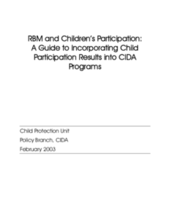Children make up 50% of the population in many countries of the world and their views and capacities can make a crucial contribution to the development of their societies. In sharing their knowledge, insights and creativity, young people are also assisted in developing important life skills such as problem analysis, democratic decision-making, developing feasible solutions and seeing these through. It is essential that society foster opportunities for children to learn and practice democracy throughout their development. The participation of girls and boys in decision-making about their lives represents a broadening and deepening of how we practice democracy.
This guide was developed to help CIDA staff and development partners incorporate child participation results into relevant project and program plans, in keeping with CIDA’s policy and practice of Results-Based Management (RBM). The guide provides a summary of learning to date on good practice in child participation; an overview of the steps to consider when planning child participation results within CIDA projects and programs; a checklist for child participation in CIDA projects; and two sample project plans in which child participation is incorporated within an RBM framework. At the end of the guide, a list of suggested resources is provided for further reading on various aspects of child participation.
The guide and its tools were developed based on the needs of stakeholders within CIDA who are currently involved in implementing projects involving child participation. It is nevertheless anticipated that this guide will be equally relevant for projects and programs with a child focus, as well as for those where there is no specific child focus but where children figure among the program’s beneficiaries. Examples for both types of projects can be found in the section on Project Models near the end of the guide. Also, while the models presented are both bilateral projects, it is anticipated that the guide will also be useful in assisting all CIDA branches (including Multilateral and Partnership) and other organizations in better understanding good practice in child participation, and in assessing how child participation results can be strengthened in their programming.
©CIDA

